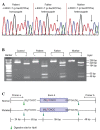Clinical and molecular study of a pediatric patient with sodium taurocholate cotransporting polypeptide deficiency
- PMID: 27882152
- PMCID: PMC5103782
- DOI: 10.3892/etm.2016.3752
Clinical and molecular study of a pediatric patient with sodium taurocholate cotransporting polypeptide deficiency
Abstract
The human solute carrier family 10 member 1 (SLC10A1) gene encodes sodium taurocholate cotransporting polypeptide (NTCP), the principal transporter of conjugated bile salts from the plasma into hepatocytes. Although the function of NTCP has been studied extensively and a number of SLC10A1 variations have been identified in humans, information regarding NTCP deficiency is limited. To date, only one patient with NTCP deficiency has been described; however, in the present study a pediatric patient who experienced intractable and striking hypercholanemia is presented. Analysis of the SLC10A1 gene in the patient revealed a homozygous p.Ser267Phe (c.800C>T) variation, which proved to be a single-nucleotide polymorphism (SNP) in the allele frequency of 4.7% of healthy controls. This variation involved a conserved amino acid residue on the orthologous alignment that was predicted to be 'disease-causing' by functional analysis using a number of bioinformatic tools. Next generation sequencing was performed; however, no other genetic causes were identified that would affect the bile acid homeostasis in the patient. Moreover, an adult, with the same genotype as the pediatric patient, was identified for the first time as experiencing mild hypercholanemia. The molecular and clinical findings in the present study suggest, for the first time, that there is an association between p.Ser267Phe SNP and hypercholanemia, and this information may be used to clinically identify NTCP deficiency worldwide.
Keywords: cholestasis; dysfunctional polymorphism; hypercholanemia; sodium taurocholate cotransporting polypeptide; solute carrier family 10 member 1 gene.
Figures


References
LinkOut - more resources
Full Text Sources
Other Literature Sources
Molecular Biology Databases
